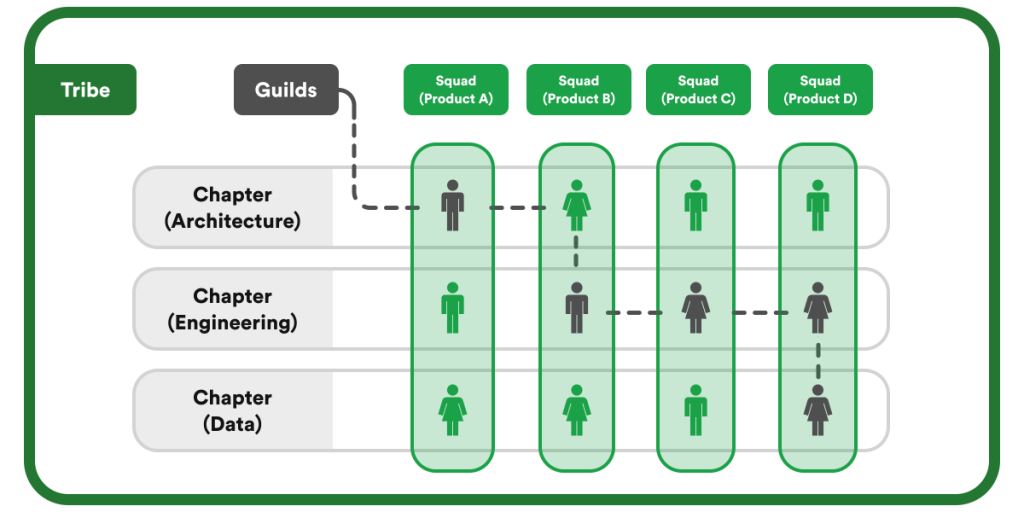
Software Teams vs. Squads: What’s the Best Approach for Your Next Project?
The article looks into advantages and disadvantages of using Agile Teams versus Agile Squads in software development projects.
On the other hand, larger organizations, particularly those with experienced scrum teams, occasionally use Squads, a model initially developed and integrated into Spotify’s organizational structure around 2014. Since then, an increasing number of Agile-focused companies have followed the industry leader in music streaming.
A squad typically comprises a compact group of developers, typically numbering between six and twelve individuals, along with a product owner who normally serves as the product manager. These squads are designed to be adaptable, versatile, and self-governing, focusing on a specific functional aspect of a company’s product line. For example, one squad might specialize in machine learning, while another concentrates on search technology.
Squads do not deal with the complete product or any specific products. Instead, they have a distinct mission to concentrate on and a product owner to provide guidance. Each squad decides on the most appropriate approach for product delivery and management.
The squad-based development model emphasizes the autonomy of each squad, but it also requires a larger structure to ensure coherence throughout the entire product. This structure is composed of the following:
Autonomous squads consist of six to 12 members, an agile coach, and a product owner, and they focus on one feature area. Each squad determines its methodologies and frameworks to support its mission.
Tribes are groups of multiple squads that collaborate on the same feature. Collaboration within a tribe is crucial for aligning the squads. Tribes usually have a tribe lead who facilitates communication and cooperation between squads.
Specialists within squads belong to chapters with specialists from other squads. Although squads are autonomous, they have to follow best practices. Chapters align on engineering standards to ensure conformity across the product. A senior technology lead manages each chapter’s team members.
Guilds are voluntary communities based on shared interests that anyone can join. Unlike chapters, which belong to tribes, guilds can cross different tribes. Guilds have community coordinators rather than leaders; their goal is to unite members around their shared interests.
Each tribe has a trio composed of a tribe lead, product lead, and design lead to ensure that all three perspectives are considered when developing features.
Large organizations may require multiple tribes to collaborate in some situations. In that case, the trio from each tribe will form an alliance, typically including three or more Trios. They work together to promote collaboration among their tribes on projects too significant for one tribe to handle alone.

In 2008, Spotify adopted a scrum team framework as their development approach. However, as the company experienced significant growth, it realized that traditional scrum practices were only sometimes the most agile option. Therefore, the team made Scrum, its methods, and terminology optional. Instead, they developed Spotify Squads, small, cross-functional, and independent teams of eight or fewer people with end-to-end responsibility for any product built.
This responsibility includes ideation, design, testing, deployment, and optimization. Each squad has a unique mission, short-term goals, and a few long-term goals that contribute to the greater company mission. In Spotify’s case, the company’s mission is to unlock the potential of human creativity.
Engineering squads have the authority to make local decisions, meaning they can move projects forward or initiate them without requiring higher approvals. Spotify established squads on the foundation of trust, relying on hiring intelligent individuals to make wise decisions and creating an autonomous workforce.
Their self-governing product squads facilitated seamless product releases. The product team desired to ship frequently and quickly, prompting them to promote “manageable” and regular releases. Additionally, Spotify restructured the product’s architecture to enable de-coupled releases. This entailed assigning specific squads to handle certain features or areas of the app rather than having all squads responsible for the entire app.
A squad-based development team’s organizational framework is created to facilitate cross-functional cooperation, independent decision-making, and agile development techniques.
A squad usually comprises 5–10 people collaborating to develop and deliver a particular product or feature. The unit structure’s essential components are as follows:
During iterative development, squads are encouraged to experiment and iterate rapidly without concern for failure. This makes it possible for the team to recognize risks, deal with them before they become significant problems, and constantly enhance the product they are developing.
Generally speaking, a squad-based development team’s structure is created to support a high degree of autonomy, collaboration, and agility. Small, cross-functional teams can produce high-quality features and products more rapidly and effectively than conventional development models by working in groups with clear objectives.
By assembling a squad with a clear mission, you can create a team of specialists rather than a collection of generalists. Squads can develop a deep understanding, intellectual capital, and expertise within their specialized functional area. Each member thoroughly comprehends all aspects of the project, facilitating the sharing of knowledge and preventing team silos. In addition, product maintenance and future phases of development are protected if a member departs.
Furthermore, each squad operates as an independent entity, like a startup. They are granted complete autonomy to update production versions and introduce new features without external approval. This results in more efficient product development, faster cycle times, and more successful products.
Working in squads also has the advantage of lowering risk. Identifying and reducing risks can be difficult when using conventional product development methods. In a squad-based model, however, each squad is responsible for locating and resolving risks associated with the feature or product they are creating. Squads are also urged to experiment and iterate rapidly because doing so can help to spot risks and deal with them before they become serious problems.
The alignment and autonomy can also be improved by working in teams. In traditional product development models, aligning various teams and stakeholders around a single objective can be difficult. However, a squad-based model simplifies ensuring everyone works toward the same goal because each squad is aligned around a particular product or feature. Additionally, squads have autonomy over how they operate and what they construct, which can enhance morale and job happiness.
Adopting a squad-based agile development model requires a change in attitude and corporate culture. The following are some measures that can be taken to implement a squad-based model:
While assembling squads, ensure they include individuals from various departments and teams. This will guarantee that the squads are cross-functional and capable of working independently.
Each squad must have well-defined objectives and metrics that align with the overall business strategy. This will ensure that everyone is working toward the same objective and can monitor progress efficiently.
Squads should use agile methodologies such as Scrum to divide work into small, manageable tasks that can be completed within a specified time frame.
Squads should be encouraged to experiment and iterate rapidly without fearing failure. This can help to identify and mitigate risks before they become significant problems.
Squads should be encouraged to work with other squads and stakeholders. This can help improve alignment and ensure everyone is working toward the same objective. Squads should also be transparent about their work, sharing updates and challenges with other teams and stakeholders.
Product squads are an excellent way to establish strong and proficient development teams. They offer the most effective development environment, enabling companies to build and release products and refine them based on user feedback quickly and efficiently.
Furthermore, product squads are a natural extension of the agile philosophy. One of the most crucial agile principles is that self-organizing teams create the best projects, requirements, and architectures. Agile development is about implementing the most effective methods rather than adhering to a particular process or rule.
It may be worth considering if the product squad approach aligns with your organization’s objectives. However, suppose you are still determining how much your product can manage independent updates at different times, or you are concerned about sacrificing overall product knowledge to enhance your organization’s functional expertise. In that case, exploring the squad method more comprehensively may be beneficial. Implementing the wrong product development strategy can lead to more difficulties than it solves.
At Rinf.tech, we have been developing Managed and Dedicated Dev Teams and Squads for other businesses across various sectors for over 16 years.
Throughout this period, we have gained valuable insights and accumulated best practices, and tribal knowledge, making us well-equipped to ensure your software project’s success.

The article looks into advantages and disadvantages of using Agile Teams versus Agile Squads in software development projects.

This article shares tips and the best practices of software team scaling from business and technical perspectives.

This article explores the concept of Squad-based product development (a.k.a. the Spotify model) and answers when it makes and doesn’t make sense to use it.
Copyright © 2023 rinf.tech. All Rights Reserved.
Terms & Conditions. Cookie Policy. Privacy Policy.
Politica Avertizari de Integritate (RO)